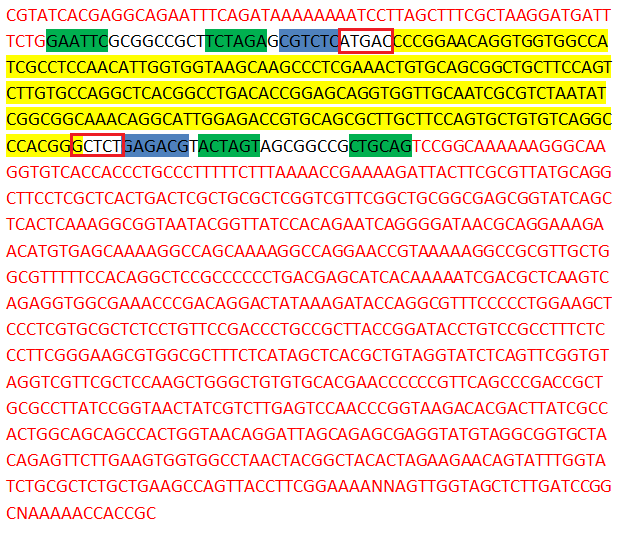Team:Freiburg/Project/Results
From 2012.igem.org
| Line 10: | Line 10: | ||
The creation of a toolkit with 96 different parts makes not only a lot of labwork but also a lot of organisation, sequencing and analysing. We dont want to present you 96 sequences of our finished biobricks but we want to give you one example of an finsihed biobrick and highlight some of the interesting and important parts of the sequence. If you are interssted in the other sequences just have a look in our parts section and go to the registry of standard biological parts. | The creation of a toolkit with 96 different parts makes not only a lot of labwork but also a lot of organisation, sequencing and analysing. We dont want to present you 96 sequences of our finished biobricks but we want to give you one example of an finsihed biobrick and highlight some of the interesting and important parts of the sequence. If you are interssted in the other sequences just have a look in our parts section and go to the registry of standard biological parts. | ||
| + | |||
| + | |||
| + | {|align="center" | ||
| + | |[[Image:AA1sequence.png|400px|no frame]] | ||
| + | |} | ||
| + | |||
| + | |||
| + | In this sequence of our biobrick AA1 the main features of all our biobricks are highlighted. In yellow you can see the direpeat itself, the green parts are the iGEM restriction sites a requirement for all biobricks, the red written sequence is part of the psb1C3 vector, the yellow part is the direpeat it self, the blue sequences are the recognition sites for BsmB1 and the red boxes are the cutting sites of BsmB1. | ||
Revision as of 13:28, 19 September 2012
Results
On this page we want to present some of our results or in other words prove for functionality of our toolkit
The toolkit
The creation of a toolkit with 96 different parts makes not only a lot of labwork but also a lot of organisation, sequencing and analysing. We dont want to present you 96 sequences of our finished biobricks but we want to give you one example of an finsihed biobrick and highlight some of the interesting and important parts of the sequence. If you are interssted in the other sequences just have a look in our parts section and go to the registry of standard biological parts.

|
In this sequence of our biobrick AA1 the main features of all our biobricks are highlighted. In yellow you can see the direpeat itself, the green parts are the iGEM restriction sites a requirement for all biobricks, the red written sequence is part of the psb1C3 vector, the yellow part is the direpeat it self, the blue sequences are the recognition sites for BsmB1 and the red boxes are the cutting sites of BsmB1.
Creation of TAL sequences - Golden Gate Cloning -
Whats so great of our toolkit is not that it has 96 parts but that these parts are able to form fully functional TAL effectors. Now to get from the toolbox to the finished TAL effector you need a few things:six direpeats, one effector backbone, three enzymes and a PCR machine. If you throw all this together its whats called Golden Gate Cloning (GGC), in this part we want to show you the results of our trials with the finished biobricks and the sequencing of the build TAL effektor constructs.
 "
"
